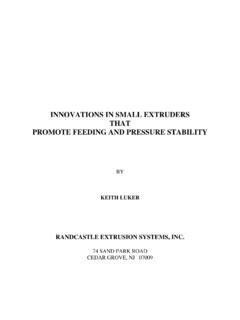Transcription of The Case for Grooved-Feed Barrels - Randcastle
1 The case for Grooved-Feed Barrels for Processing LDPE-LLDPE Presented By Keith Luker Randcastle Extrusion Systems, Inc. INTRODUCTION: Processors of blown film are faced with the question, "What type of extruder is best for my application?" The word, "best," like beauty, is a matter of the beholder. Nevertheless, clearly grooved Barrels offer significant processing advantages in many applications. The purpose of this paper is to explain how grooved feed Barrels work and the advantages (and pitfalls) that follow. SPECIAL NOTE: In order to write this paper, I relied heavily on input from Andrew Wheeler and Matt Bangert.
2 For their effort, I wish to thank them. Any errors that may have occurred in my understanding from them, though, are my responsibility completely. DEFINITION: Most extruders have a separate barrel section under the hopper. If this section is smooth, the extruder is call a smooth barrel extruder. If this portion of the barrel is grooved , then the extruder is call a grooved barrel extruder. Sometimes, this portion of the barrel is called the, " feed section." Unfortunately, the first part of the screw is sometimes called the feeding section of the screw and this can lead to confusion.
3 In this paper, we will use the term " grooved barrel " exclusively. HOW grooved Barrels WORK: Single screw extruders convey polymer pellets by means of friction. The barrel , by means of frictional contact with the pellets, drags the material over the screw against the helix and the pellets advance. This is true even though the barrel is stationary. The process can be pictured as a stationary screw and a revolving barrel about the screw. Or, if you picture a nut on a bolt, the nut will only move forward on the revolving screw if the nut rotates slower than the screw.
4 Similarly, the plastic pellets will only move forward if the drag from the barrel is greater than the resistance of the pellets on the screw. In an extruder equipped with a totally smooth bore, there is a very significant amount of slippage in the system as the pellets tumble and slide. The pellets act like ball bearings where the contact between the barrel and pellet surface is small. This is why the apparent compression ratio is typically between and :1 for smooth barreled extruders. (The apparent compression ratio is the ratio of the screw's thread depth in the first flight divided by the screw's thread depth in the last flight.)
5 In a sense, the apparent compression ratio of a properly functioning screw is a measure of how well pellets are transported. In a smooth bore barrel , the pellets follow a helical path in the solids conveying section of the screw. That is, they are pushed along the helix of the screw taking a slow winding path. In a " grooved " feed barrel , one or more grooves are added to the bore of the barrel under the hopper and into the solids conveying zone. The grooves are usually parallel to the bore. The grooves continue beyond the opening in the hopper for 1 to 6 L/D's.
6 Three manufacturers (Ref.: 1, 2 , 3) of blown film equipment were surveyed and they all report a typical L/D ratio of :1. The grooves do not extend beyond the solids conveying section as they work only on solids rather than melted material. Therefore, grooved feed sections are intensively water cooled (Ref. 1,2,3,4) to prevent premature melting. Specific guidelines for screw geometry are proprietary. However, general guidelines (Ref. 3) are that the extruder diameter (in inches) divided by will give the number of grooves. The same reference suggests groove width of to inches and a taper of 3 degrees for the grooves.
7 Besides rectangular grooves, the grooves may be trapezoidal or hemispherical (Ref.: 2). Helical grooves have not met with widespread success. Thread depths in the solids conveying zones are shallow compared to smooth bore Barrels . This is because the increased efficiency of transportation means that large depths are not necessary to fill the metering section of the screw. Typical flight depths between to inches are reported (Ref. 3). WHY GROOVES WORK: In effect, the pellets become trapped in the grooves and advance against the helix of the screw.
8 So, instead of advancing slowing along the helix of the screw, the pellets advance forward in the grooves pushed by the helix. This means that there is a tremendous increase in transportation. Typically, apparent compression ratios are only 1:1 and yet still allow the metering section of the screw to be filled. This indicates very efficient transportation. It may appear, that such efficient transportation is impossible because it implies that transportation is at 100%. This is not the case . Transportation can never be perfect.
9 However, it must be remembered that polymers expand significantly (many in the area of 25%) in volume as they are heated to process temperature. This increase in volume allows the metering section to be filled with less than perfect transportation and with only 1:1 compression ratio screws. In fact, screws designed for use with grooved Barrels not only use low compression screws, they typically increase the pitch of the screw (Ref.: 1,2) to accommodate the increased volume. Alternatively, the thread depth is increased (Ref.: 3, 5) although in practice this is less common probably because the increased helix angle makes for a more efficient pump for molten polymer (Ref.)
10 : 6) ADVANTAGES OF grooved Barrels This increased pumping efficiency of the grooved barrel extruder has several interesting results. These results become advantages for blown film applications and LDPE and LLDPE in particular. HIGH PRESSURE DEVELOPMENT: In a smooth bore extruder, the pressure in the solids conveying zone of the screw has been measured (Ref. 11) and shown to be very low. Often, for the first 5 flights, pressure is so low that pressure gages read zero. Typically, pressure rises through the melting section of the screw and reaches its highest point at the end of the transition zone (Ref.








